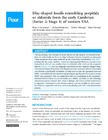Disc-shaped fossils resembling porpitids or eldonids from the early Cambrian (series 2: stage 4) of western USA
Citation
Lieberman et al. (2017), Disc-shaped fossils resembling porpitids or eldonids from the early Cambrian (Series 2: Stage 4) of western USA. PeerJ 5:e3312; DOI 10.7717/peerj.3312

View/
Date
2017Author
MacGabhann, Breandán Anraoi
Lieberman, Bruce S.
Kurkewicz, Richard
Shinogle, Heather
Kimmig, Julien
Peer Reviewed
YesMetadata
Show full item record
Lieberman et al. (2017), Disc-shaped fossils resembling porpitids or eldonids from the early Cambrian (Series 2: Stage 4) of western USA. PeerJ 5:e3312; DOI 10.7717/peerj.3312
Abstract
The morphology and affinities of newly discovered disc-shaped, soft-bodied fossils from the early Cambrian (Series 2: Stage 4, Dyeran) Carrara Formation are discussed. These specimens show some similarity to the Ordovician Discophyllum Hall, 1847;
traditionally this taxon had been treated as a fossil porpitid. However, recently it has instead been referred to as another clade, the eldonids, which includes the enigmatic Eldonia Walcott, 1911 that was originally described from the Cambrian Burgess Shale.
The status of various Proterozoic and Phanerozoic taxa previously referred to porpitids and eldonids is also briefly considered. To help ascertain that the specimens were not dubio- or pseudofossils, elemental mapping using energy dispersive X-ray spectroscopy (EDS) was conducted. This, in conjunction with the morphology of the specimens, indicated that the fossils were not hematite, iron sulfide, pyrolusite, or other abiologic mineral precipitates. Instead, their status as biologic structures and thus actual fossils is supported. Enrichment in the element carbon, and also possibly to some extent the elements magnesium and iron, seems to be playing some role in the preservation process.
Keywords
PorpitidHydrozoa
Cnidaria
Cambrian
Burgess shale type fossil
Elemental mapping
Eldonid

